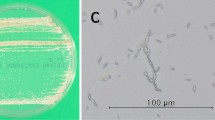Abstract
Two cases of peritonitis caused byAcremonium kiliense in patients receiving a continuous ambulatory peritoneal dialysis treatment are reported. Diagnosis was established by direct examination and cultures of dialysis effluent, secretion of catheter-exit-site and from the tip of the catheter. Management of fungal peritonitis includes catheter removal, since in this infection the result of systemic antifungal therapy is inconsistent.
Similar content being viewed by others
References
Vas SI. Infections associated with peritoneal and hemodialysis. In: Bisno AL, Waldvogel FA (eds), Infections associated with indwelling medical devices, Washington, DC: American Society for Microbiology, 1989: 215–48.
von Graevenitz A, Amsterdam D. Microbiological aspects of peritonitis associated with continuous ambulatory peritoneal dialysis. Clin Microbiol Rev 1992; 5: 36–48.
Kwon-Chung KJ, Bennett JE. Infections due to miscellaneous molds. In: Kwon-Chung KJ, Bennett JE (eds), Medical mycology. Philadelphia: Lea & Febiger, 1992: 733–67.
Douglas R, Sympson SE.Cephalosporium in pleural fluid. Am Rev Tuberc 1943; 48: 237–40.
Ward HP, Martin WJ, Ivins JC, Weed L.Cephalosporium arthritis. Proc Meet Mayo Clin 1961; 36: 336–43.
Szombathy SP, Chez MG, Laxer RM. Acute septic arthritis due toAcremonium. J. Rheumat 1988; 15: 714–15.
Cowen DE, Dines DE.Cephalosporium midline granuloma. An Intern med 1964; 60: 731–32.
Drouhet E, Martin L, Segretain G, Destombes P. Mycose méningo-cérébrale aCephalosporium. Pres Med 1965; 75: 1809–14.
Papadatos C, Pavlatou M, Alexiou D.Cephalosporium meningitis. Pediatrics 1969; 44: 749–51.
Degeorges M, Heintz CH, Valty J, Drouhet E, Acar JF, Leduc G. Endocardite infectieuse aListeria monocytogenes et aCephalosporium. Pres Med 1971; 79: 1377–80.
Lacaz CS, Porto E, Carneiro JJ, Paxianni IO, Pimenta WP. Endocardite em prótese de dura-mater provocada peloAcremonium kiliense. Rev Inst Med trop São Paulo 1981; 23: 274–79.
Boltansky H, Kwon-Chung KJ, Macher AM, Gallin JI.Acremonium strictum-related pulmonary infection in a patient with chronic granulomatous disease. J. Infect Dis 1984; 149: 153.
Wetli CV, Weiss SD, Cleary TJ, Gyori E. Fungal cerebritis from intravenous drug abuse. J. Form Scien 1984; 29: 260–68.
Brabender W, Ketcherside J, Hodges GR, Rengachary S, Barnes WG.Acremonium kiliense osteomyelitis of the calvarium. Neurosurgery 1985; 16: 554–56.
Strabelli TMW, Uip DE, Bocchi E et al. Infecção porAcremonium sp após transplante cardíaco. 26th Cong Soc bras Med trop 1990; 302–03.
Van Etta LL, Peterson LR, Gerding DN.Acremonium falciforme (Cephalosporium falciforme) mycetoma in a renal transplant patient. Arch Dermatol 1983; 119: 707–08.
Onorato IM, Axelrod JL, Lorch JA, Brensilver JM, Bokkenheuser V. Fungal infections of dialysis fistulae. An Intern Med 1979; 91: 50–52.
Landay ME, Greenwald JH, Stemer AA, Ashbach DL.Cephalosporium(Acremonium) in dialysis-connected peritonitis. J Ind St Med Assoc 1982; 75: 391.
Eisenberg ES, Leviton I, Soeiro R. Fungal peritonitis in patients receiving peritoneal dialysis: experience with 11 patients and review of the literature. Rev Infect Dis 1986; 8: 309–21.
Saklayen MG. CAPD peritonitis. Incidence, pathogens, diagnosis and management. Med Clin N Am 1990; 74: 997–1010.
Stewart WK, Anderson DC, Wilson MI. Hazard of peritoneal dialysis: contaminated fluid. Brit Med J 1967; 1: 606–07.
Author information
Authors and Affiliations
Rights and permissions
About this article
Cite this article
Lopes, J.O., Alves, S.H., Rosa, A.C. et al. Acremonium kiliense peritonitis complicating continuous ambulatory peritoneal dialysis: report of two cases. Mycopathologia 131, 83–85 (1995). https://doi.org/10.1007/BF01102883
Received:
Accepted:
Issue Date:
DOI: https://doi.org/10.1007/BF01102883




